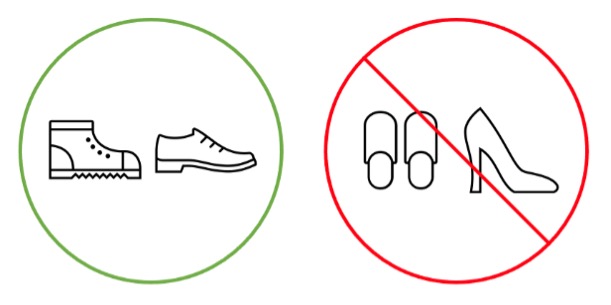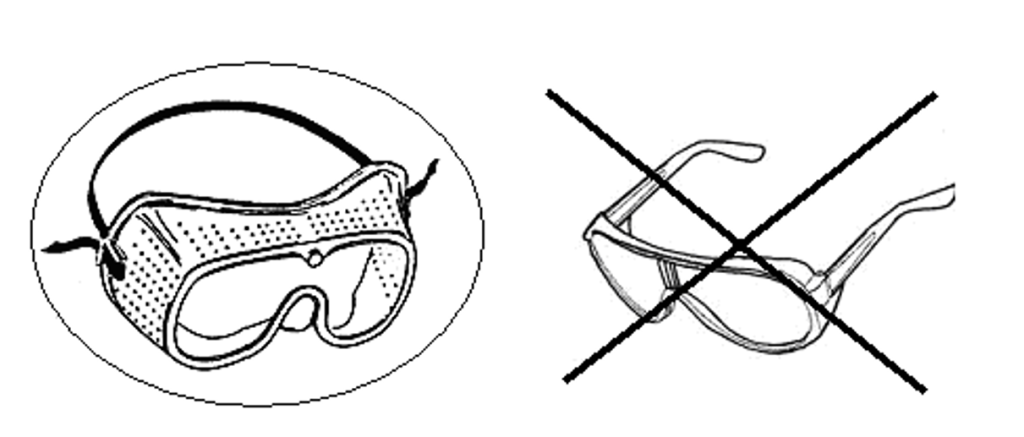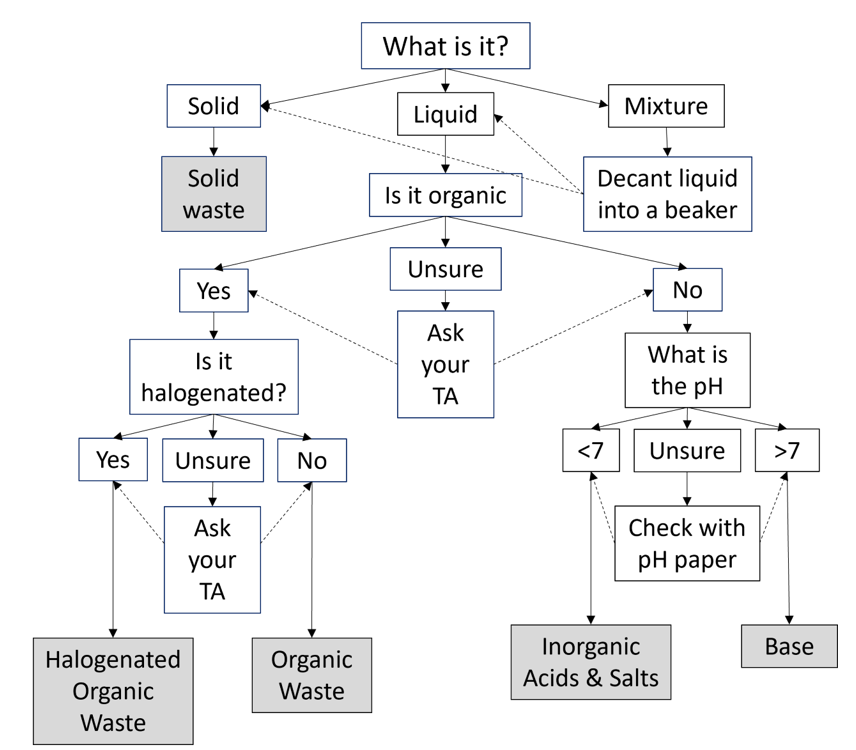Safety Guidelines
Knowing the hazards and working consciously are the best methods for preventing accidents in the laboratory. Outlined below are precautions that need to be taken to work safely.
IF AT ANY POINT DURING AN EXPERIMENT, YOU FEEL YOUR OR ANYONE ELSE’S SAFETY IS AT RISK, IT IS YOUR RIGHT, AND OBLIGATION, TO POINT OUT THE HAZARD TO A TEACHING ASSISTANT, TECHNICIAN OR LABORATORY COORDINATOR.
Clothing
Inappropriate attire is subject to the discretion of the Laboratory Coordinator. Students not dressed accordingly may forfeit their ability to complete an experiment. Remember, this is a chemistry lab, not a fashion show!
- Students are strongly encouraged to come with a lab coat for each experiment. This is your primary defense against spills. Chemicals and skin do not combine well!
- Shoes must completely cover your feet. This includes the entire upper foot, toes, and heels.
- Sandals, open-toed shoes, ballerina shoes (flats) and shoes with cut-outs or openings are not acceptable attire.
- Running shoes and boots are generally acceptable.
- Due to slipping hazards, shoes or boots with heels are strongly discouraged.

Figure 4-Lab footwear should cover your entire foot
- Students must be wearing long pants or a long skirt to gain entry to the labs. Pants should not have excessive rips/tears in them. Capri-pants, short skirts, or shorts are not permitted.
- Clothing that hangs excessively, such as loose sleeves and scarves, should not be worn in a laboratory as they are a potential safety hazard around equipment and chemicals. Similarly, long hair must be tied back.
- Headphones are not permitted at any point during the lab as they prevent you from hearing verbal announcements or warnings.
Eye Protection
- Splash hazards represent a significant danger to students during experiments and thus safety goggles, not safety or prescription glasses, are mandatory at all times in the lab. Students forgetting their goggles may rent them from ABB 127 at a cost of $2.00 per experiment.

Figure 5 – Only safety goggles (left) are permitted in undergraduate laboratories
- Goggles must be worn over prescription eyeglasses. Contact lenses should be avoided in the lab as there is the potential for an adverse reaction between a contact lens and certain chemicals.
- Students who do not always wear eye protection in the laboratory will be asked to leave the lab and given a mark of zero for the experiment.
Chemical Handling and Spills
- If you spill a small amount of a chemical on your skin, wash the area immediately with water and inform your TA at once.
- Do not taste or directly smell chemicals. If smelling needs to occur, gently waft the vapours towards your nose.
- Do not pipet by mouth; always use a rubber bulb.
- Carefully handle all chemicals to avoid spills and waste. Replace caps after use and clean up spills immediately. Unused chemicals are put into the appropriate waste beaker, not back into the stock containers.
- Inform your TA about any major spills. There are spill kits in every lab that may be used by your TA.
- Make sure you wash your hands with soap and water when finishing your experiment and before leaving.
Glassware
- If glassware is going to be heated, carefully inspect it beforehand for cracks or chips. Dispose of broken glass only in the containers provided and not the regular garbage.
- Use care when working with glass apparatus. Be cautious and careful when pushing a glass tube through a hole in a rubber stopper.
- Keep glassware away from the edge of the bench.
- Never pick up pieces of broken glass with your hands. A brush and dustpan are provided for broken glassware.
- If something is missing from your drawer when you arrive, notify a technician promptly. You are responsible for broken glassware. Price lists are available in the lab.
Waste
- All waste must go in the appropriate containers provided. Use the following flowchart to help you decide where waste must go.

Figure 6 – Flowchart for handling chemical waste in the lab
Emergencies
- All injuries, no matter how small, must be reported immediately to the lab TA, a technician, or the Laboratory Coordinator. An incident report must be filed whenever an injury requires medical treatment.
- For a major chemical spill on clothing or a person, or clothing on fire:
- Immediately put the victim under the emergency shower to extinguish flames or wash off chemicals. Immediately remove all contaminated clothing.
- Get medical attention at once.
- Never use a fire extinguisher on a person.
- Minor burns should be flushed with cold water for several minutes, followed by appropriate medical attention.
- For chemicals splashed on the eyes or face, get the injured person to the eyewash station immediately. Flush eyes with water for 15–20 minutes, holding the eye open to ensure washing. Seek further medical attention in the event the chemicals were hazardous chemicals, or any ill effects persist. Take a current copy of the MSDS with you.
- The laboratory is equipped with class ABC fire extinguishers (suitable for most common fires) and a sand pail (suitable for metal fires, such as sodium, potassium, etc.). In the event of a fire, the room and building should be evacuated, and TA, technician or Lab Coordinator alerted (if possible to do so safely).
- The fire alarm should be pulled while exiting the building. Students should not attempt to put out a fire.
- Minimize accidents by coming prepared and working carefully and alertly. Learn the location and operation of safety showers and eyewashes. Know the exit route from the lab and the building.
General Behaviour
- Eating, drinking, chewing gum, and applying makeup/chapstick in the laboratory are not permitted.
- Unauthorized experiments are strictly forbidden. This includes any unnecessary, intentional alteration of the given procedure.
- No unauthorized people are allowed in the lab. This includes casual visitors.
- No horseplay will be tolerated in the laboratory.
- If you are feeling unwell, report it to your lab TA immediately.
- At the beginning of your lab session, place jackets, backpacks and other unnecessary items in the cupboard below your fume hood.
- Once you have removed the equipment you need from your equipment drawer, be sure to close it again. Open drawers pose serious tripping hazards.
- Cell phones are not permitted in the lab. Leave any laptops/cellphones/tablets in your coats or bags. These items can be stored in the lockers underneath the benches.
